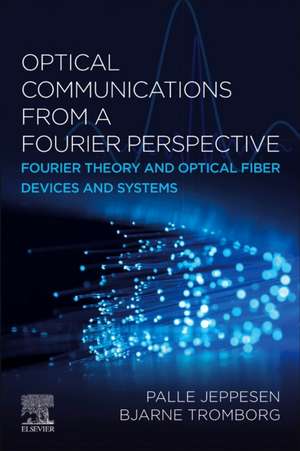Optical Communications from a Fourier Perspective: Fourier Theory and Optical Fiber Devices and Systems
Autor Palle Jeppesen, Bjarne Tromborgen Limba Engleză Paperback – 19 noi 2023
- Introduces Fourier theory and signal analysis tailored to applications in optical communications devices and systems
- Provides a strong theoretical background and a ready resource for researchers and advanced students in optical communication and optical signal processing
- Starts from basic theory and then develops descriptions of useful applications
Preț: 1245.07 lei
Preț vechi: 1633.62 lei
-24% Nou
Puncte Express: 1868
Preț estimativ în valută:
238.24€ • 248.74$ • 197.18£
238.24€ • 248.74$ • 197.18£
Carte tipărită la comandă
Livrare economică 28 martie-11 aprilie
Preluare comenzi: 021 569.72.76
Specificații
ISBN-13: 9780443238000
ISBN-10: 0443238006
Pagini: 506
Dimensiuni: 152 x 229 x 30 mm
Greutate: 0.67 kg
Editura: ELSEVIER SCIENCE
ISBN-10: 0443238006
Pagini: 506
Dimensiuni: 152 x 229 x 30 mm
Greutate: 0.67 kg
Editura: ELSEVIER SCIENCE
Cuprins
1. The Dirac delta function and Heaviside step function
2. Fourier series, Parseval's theorem, FFT and Cooley-Tukey algorithm
3. Fourier integrals and Fourier series
4. Properties of the Fourier transform and Heaviside's step function
5. Complex signal, complex envelope and Hilbert transform
6. Correlation functions, spectral density, Wiener-Khinchine theorem
7. Linear, time-invariant systems
8. Transfer matrices and frequency filters
9. Laplace transforms, transfer functions, Nyquist criterion
10. Maxwell's equations, optical waveguides and Poynting's vector
11. Pulse propagation in optical fibers
12. Split step Fourier method and nonlinear Schrodinger equation
13. Introduction to modulation formats
14. Required bandwidth for heterodyne and homodyne detection
15. Bandpass noise
16. Bit error rate
17. Pulse shaping using optical Fourier transform
18. Spectrum magnification
19. Optical Fourier transformation, dispersion compensation, jitter suppression
20. Regeneration of WDM phase-modulated signals
21. Time-space duality, dispersion and diffraction, time lens
22. Couplers and their use for optical DFT
23. Multicarrier modulation, OFDM, DFT, Nyquist modulation
24. Optical orthogonal frequency division modulation
2. Fourier series, Parseval's theorem, FFT and Cooley-Tukey algorithm
3. Fourier integrals and Fourier series
4. Properties of the Fourier transform and Heaviside's step function
5. Complex signal, complex envelope and Hilbert transform
6. Correlation functions, spectral density, Wiener-Khinchine theorem
7. Linear, time-invariant systems
8. Transfer matrices and frequency filters
9. Laplace transforms, transfer functions, Nyquist criterion
10. Maxwell's equations, optical waveguides and Poynting's vector
11. Pulse propagation in optical fibers
12. Split step Fourier method and nonlinear Schrodinger equation
13. Introduction to modulation formats
14. Required bandwidth for heterodyne and homodyne detection
15. Bandpass noise
16. Bit error rate
17. Pulse shaping using optical Fourier transform
18. Spectrum magnification
19. Optical Fourier transformation, dispersion compensation, jitter suppression
20. Regeneration of WDM phase-modulated signals
21. Time-space duality, dispersion and diffraction, time lens
22. Couplers and their use for optical DFT
23. Multicarrier modulation, OFDM, DFT, Nyquist modulation
24. Optical orthogonal frequency division modulation
Recenzii
"...the book contains a short discussion on the basic relations for the wave propagation in optical fibers but a detailed discussion of the specific propagating modes is outside the scope of this book… An important focus of the book is related to all-optical signal processing... This book covers a vast amount of material and it impresses by a very thorough analysis with extensive appendices... The book is thus very well suited for an advanced undergraduate student with respect to the first part of the book and for a graduate student with respect to the second part of the book. It is also very helpful that each chapter is concluded with a short summary at its end... represents a valuable extension to the existing literature providing the reader with a very deep knowledge for better understanding advanced optical communication systems." --Klaus Petermann, Technische Universität Berlin, Germany, IEEE Photonics Society News
